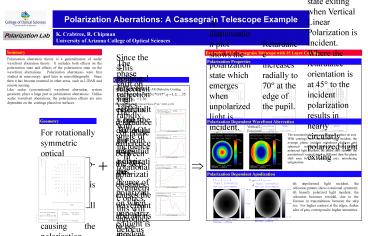Polarization Aberrations: A Cassegrain Telescope Example - PowerPoint PPT Presentation
1 / 1
Title:
Polarization Aberrations: A Cassegrain Telescope Example
Description:
Polarization aberrations were first studied in microscopy qand later in microlithogrophy. ... Polarization Dependent Wavefront Aberration ... – PowerPoint PPT presentation
Number of Views:155
Avg rating:3.0/5.0
Title: Polarization Aberrations: A Cassegrain Telescope Example
1
Polarization Aberrations A Cassegrain Telescope
Example
K. Crabtree, R. Chipman University of Arizona
College of Optical Sciences
Summary
Example F/1.5 Cassegrain Telescope with 35
Layer Coating
Polarization aberration theory is a
generalization of scalar wavefront aberration
theory. It includes both effects on the
polarization state and effects of the
polarization state on the wavefront aberrations.
Polarization aberrations were first studied in
microscopy qand later in microlithogrophy. Since
then it has become essential in other areas, such
as LIDAR and remote sensing. Like scalar
(conventional) wavefront aberration, system
geometry plays a large part in polarization
aberrations. Unlike scalar wavefront
aberrations, the polarization effects are also
dependent on the coatings placed on surfaces.
Polarization Properties
Polarization state exiting when Vertical Linear
Polarization is Incident. Where the retardance
orientation is at 45 to the incident
polarization results in nearly circularly
polarized light exiting
A diattenuation plot shows the polarization
state which emerges when unpolarized light is
incident.
Retardance increases radially to 70 at the edge
of the pupil.
Coatings
Polarization Dependent Wavefront Aberration
Unpolarized Light Incident
Vertical Linear Polarization Incident
The uncoated telescope wavefront is perfect on
axis. With coatings, and unpolarized light
incident, the average phase incident introduces
defocus and spherical wavefront aberration.
With linearly polarized light incident, the phase
shift seen by the p-polarized (vertical) axis is
different than the phase shift seen by the
s-polarized axis, introducing astigmatism.
Polarization Dependent Apodization
Unpolarized Light Incident
Vertical Linear Polarization Incident
With unpolarized light incident, the apodization
pattern shows rotational symmetry. With linearly
polarized light incident, the apodization becomes
toroidal, due to the difference in transmittance
between the sp states. For higher contrast at
the edges, darker shades of gray correspond to
higher intensities.































